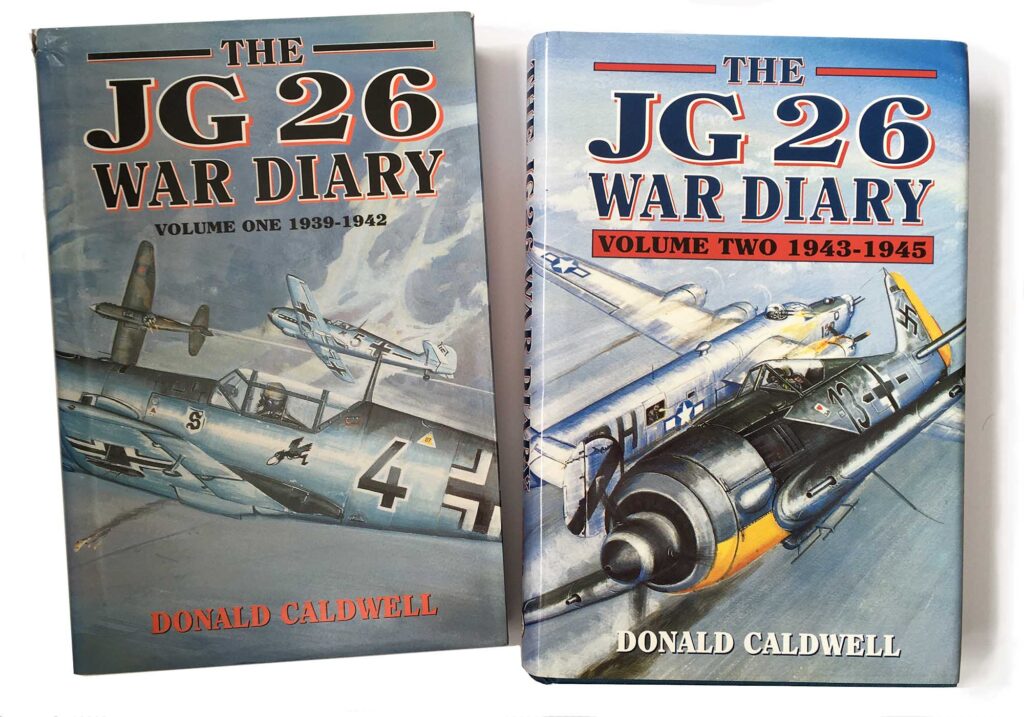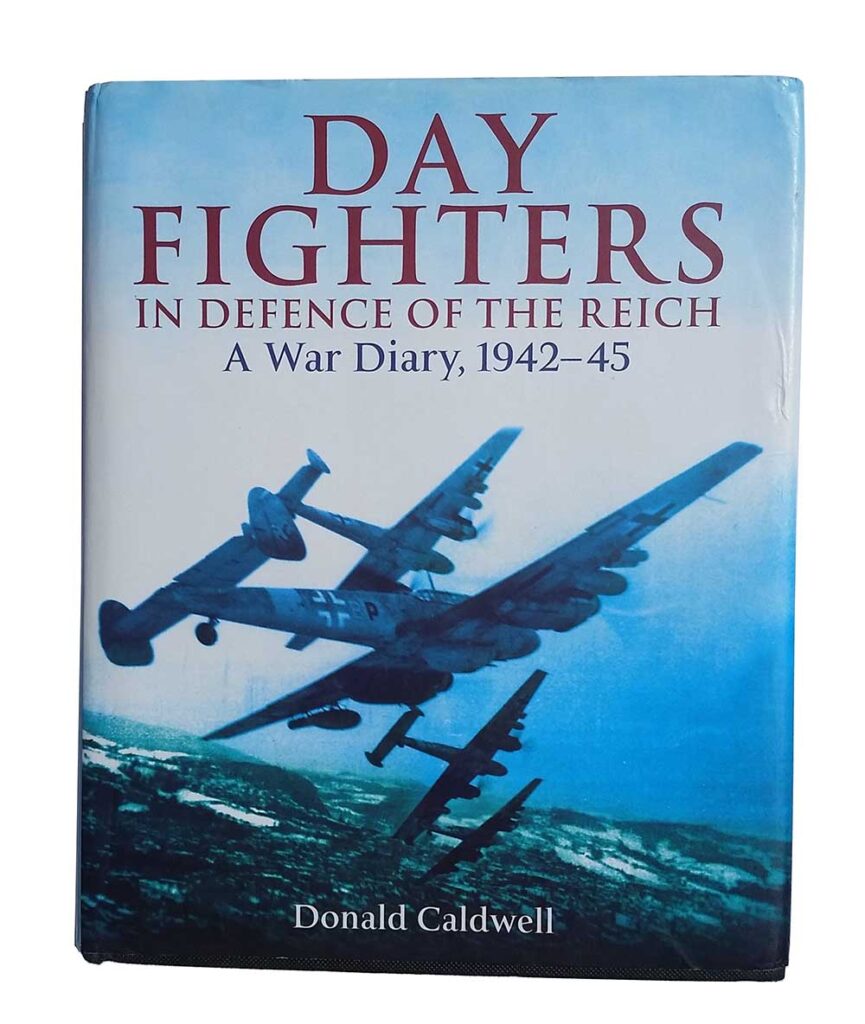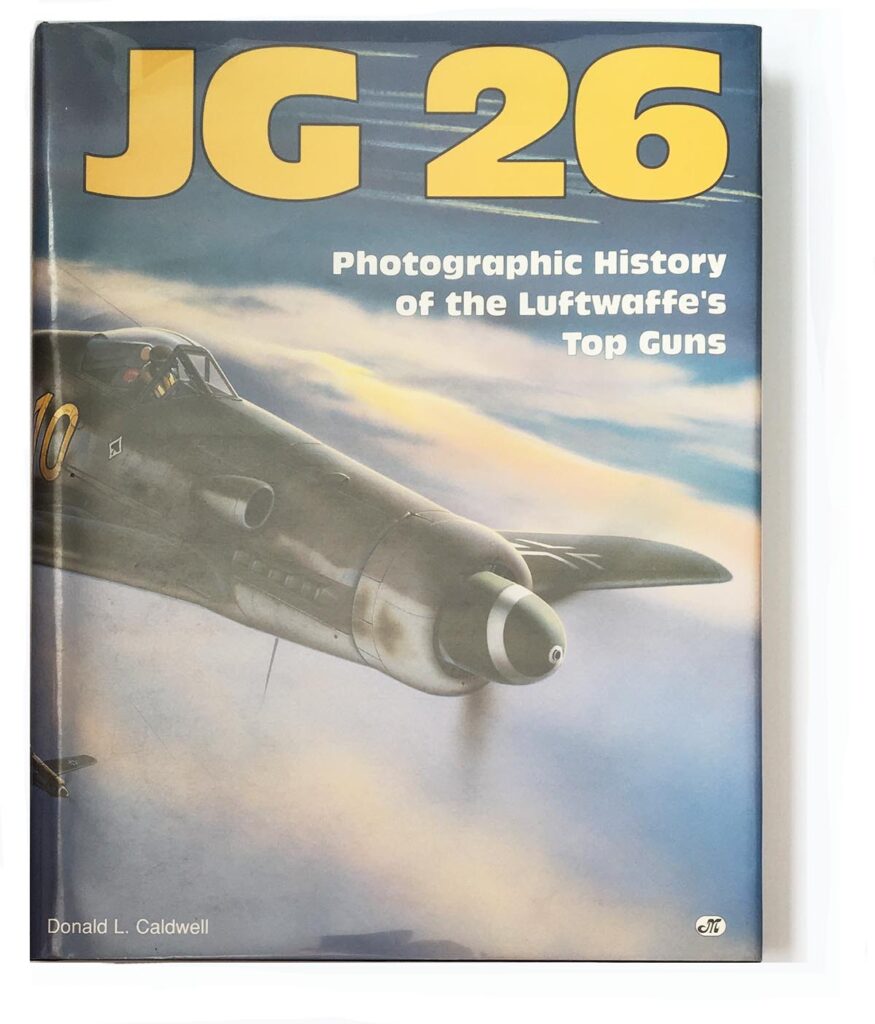Throughout the period the Air War Publications team has been researching and writing about Second World War aviation history, Donald Caldwell has been an established and respected researcher and author, who has helped us with information or photographs on several occasions to improve some of our projects. Although mainly known for his books about the history of Jagdgeschwader 26, he has also written about other topics. After his JG 26 books, many people were hoping he would choose another Luftwaffe fighter unit as his next research project. Instead, he choose to use his time and knowledge gained in the twenty years researching JG 26 to write a book “one level up” from unit-level. The result was the book The Luftwaffe Over Germany: Defense of the Reich, describing the daytime air war over Western Europe between 1942 and 1945.
Morten was close to meeting Donald in person back in 1999 when he studied in Akron, Ohio, for the autumn semester. Donald, by then living in Lake Jackson, Texas, had invited Morten to visit, but the eight-hour Greyhound bus trip was a bit too long for Morten, and difficult to fit in with his studies. Fast forward two decades, and Morten was able to conduct an interview with him. We hope you enjoy getting to know Donald just as much as Morten did interviewing him.

1. When and how did you become interested in researching the Luftwaffe in the Second World War?
World War II was the most significant historical event of the Twentieth Century. The war and its immediate aftermath determined the nature of the world I grew up in. I have been interested in the history of the war since childhood. The battle for air supremacy over the skies of Western Europe between the Luftwaffe and the air forces of the Western Allies – first the Royal Air Force, and later the US Army Air Force – continued for the entire war, from 1939 to 1945. This remains the world’s most important aerial campaign in terms of scale, length, and ultimate result.
2. What was the first Luftwaffe subject you really looked into?
The Luftwaffe fell from a position of European dominance to virtual extinction in the brief period of one year, 1944. The German fighter arm lost more than 100 per cent of its strength in pilots, and with them almost all of its effectiveness, during this year. Why and how did this occur? Just as important, what was it like for the men who survived? I couldn’t find out in 35 years of reading published histories. All aspects of the Allied side of the air war had been covered thoroughly and repeatedly by historians, to the extent that by the ‘80s the histories being written quoted each other more than they quoted primary references. Things were even worse for the Luftwaffe. The histories available in English were few in number, and their scope left much to be desired. My search for answers led me to the histories written in the German language, which thanks to the Rice Science-Engineering curriculum of the late ‘50s I could still read (laboriously). The situation there was little better. A few good histories and memoirs were written in the 1950s, which was too soon after the war for any attempt at objectivity. None of these early books made use of Allied records and were thus seriously short of “context”. Books written in Germany more recently have the same failings as those available in English – they are highly derivative and non-analytical. Serious, objective historical research into the period has rarely been attempted in Germany. There are two reasons for this – first, since most Germans wish the years 1933-1945 had never happened, there is very little interest in the period by either historians or the general public; and second, most of the official Luftwaffe records were ordered to be destroyed several days before the war ended in May 1945, leaving professional historians little to work with.

3. How did you become interested in Jagdgeschwader 26?
Ultimately, I concluded that no aviation history or memoir written exclusively from the point of view of one of the combatants could ever tell me what really happened – air battles are just too chaotic for that. The type of critical analysis that I sought had apparently never even been attempted. In mid-1985 I experienced a sort of epiphany – I realized that the book I had been looking for did not exist, and would never exist, unless I researched and wrote it myself. I briefly considered writing a history of the entire Jagdwaffe. But since I felt it important to cover the human side of Luftwaffe service, I soon realized that I needed to narrow my scope, preferably to a single unit. My attention was drawn to JG 26, without question the best German fighter unit for much of the war. Some highlights of its history were already known to me. During the Battle of Britain it was commanded by Adolf Galland, the most famous Luftwaffe pilot. JG 26 spent the entire war on the Western Front – at times as the only aerial defender of Germany’s West Wall. It was the Luftwaffe unit most respected by the British and the Americans, and the only one that they nicknamed as a mark of that respect – they were the ‘Abbeville Kids’. The early American heavy bomber raids suffered very heavy losses, approaching ten per cent per mission. JG 26 was a front-line defender against these early raids. However, the Allies quickly got the upper hand. If you read Cornelius Ryan’s The Longest Day, or saw the movie, you remember that only two German fighters succeeded in penetrating the Allied aerial umbrella over the Normandy beachhead on D-Day morning. It so happens that they were piloted by the commander of JG 26, Josef Priller, and his wingman.
4. What was the hook, or the moment that made you realize you wanted to carry on down the path of research?
I realized that the history of this one wing mirrored in microcosm the rise and fall of the entire Luftwaffe. Fortunately, JG 26 was the subject of a German-language history written in 1956 by Josef Priller. I had his book and saw that it could provide the chronological framework upon which to hang the results of my own work. Thus, in the fall of 1985 I began the research that resulted in JG 26: Top Guns of the Luftwaffe.
5. How did you manage to contact so many pilots and ground crew from JG 26?
A notice in Jägerblatt (the publication of the German fighter pilot association) brought several replies, from fellow researchers as well as pilots. After finally obtaining an address list from the Gemeinschaft, I wrote letters to a number of JG 26 veterans in my best college German. I ultimately located and wrote a majority of JG 26’s surviving pilots – which totalled fewer than 200 men of the 2.000 who had served. I was overwhelmed by the response. More than half of them replied – some simply to tell me that they had no desire to relive those terrible days, and so did not want to help me. I succeeded in obtaining first-hand information from about 60 former members of JG 26, ranging from Kommodore to raw enlisted pilot, plus several members of the ground crew. The cooperation I got from the veterans of the unit was what made the book possible. I’m still amazed that my letters – which came to them out of the blue from a stranger, a novice author, and a former enemy – were answered with such an outpouring of documents, photographs, and incredibly frank accounts. I attribute my success to two factors – first, the veterans were flattered at being sought out by an American who wrote to them in German; and second, many of them had repressed their experiences, the most vivid of their lives, for more than 40 years – because no-one, not even their children, wanted to hear about them. Unfortunately, time has taken its inevitable toll, and virtually none of these men are still with us. A book based primarily on unpublished first-hand accounts from World War II veterans would hardly be possible today.
6. What was the first book you wrote, and when was it published?
I titled my first manuscript The Abbeville Kids, and it was ultimately published as JG 26: Top Guns of the Luftwaffe. I was spared the degrading experience of most first-time authors, that of trolling the manuscript past a number of publisher’s offices. I found my publisher very early, through a stroke of luck. A large New York publisher, Crown, had established a special imprint for a line of military histories and had hired Walt Boyne, a noted aviation author, as a consulting editor. After Walt reviewed my table of contents, a précis, and a sample chapter, he sold Crown on the concept, and we soon came to terms on a contract. The manuscript was completed and sent to Crown (now part of Random House) in July 1989, but personnel and policy changes kept it from being picked up by my new editor and prepared for publication until early 1991. The book turned out better than I had hoped. A top-rank publisher provides excellent copy-editing, layout, proof reading, indexing, etc. – all summed up as production values. It can work the review and placement games and is a master of secondary sales – Top Guns was sold to several book clubs, was translated into four languages, and its paperback edition stayed in print for fifteen years. Total sales exceed 100.000 copies.
7. What is your most memorable moment meeting a World War II veteran?
There were too many notable meetings with JG 26 veterans to mention, but there were a couple of memorable ones with Adolf Galland. The first was in his home in Remagen, where I had hand-carried a foreword for Top Guns for him to read, approve and sign. His wife Heidi kept him on a very tight schedule, but our one-hour meeting turned into four, during which Heidi fixed us a Nudelabendessen. The next was in Fürstenau a year before he died, at the first successful JG 26 reunion in 50 years (blame politics). From the podium Galland credited me, “ein Gegner”, for providing the impetus for getting the group together.
8. What made you write The Luftwaffe over Germany: Defence of the Reich book?
My JG 26 research continued while Random House sat on, and then worked on, Top Guns. It was impossible to stop the flow of data and photographs from my many helpers. I eventually had enough material to publish a JG 26 Photo History, a two-volume JG 26 War Diary, and a brief co-authored biography of Adolf Galland, all with different publishers. I was then through with JG 26, and was ready to broaden my research to cover the entire air defense of the Third Reich. I met Dr. Richard Muller at a meeting of a group of Luftwaffe enthusiasts. Our interests and accomplishments were similar – his dissertation had been on early Luftwaffe history – and we decided to team up on this book. It as a critical success, winning the Air Force Historical Foundation Best Air Power History Book Award for 2008, but sales were only mediocre. I nevertheless pressed on alone on a follow-up volume, Day Fighters in Defense of the Reich: A War Diary 1942-1945, which depleted my research files and ended my interest in personal research on the Luftwaffe.
9. What is your current primary research focus?
I thought that I was through with researching and writing, but an Ohio National Guard member got me interested in a Guard tank company that was surrendered on Bataan in 1942. He had a huge file of research material but did not like to write, and we eventually teamed up to work on a history of the Provisional Tank Group, which contained six of these companies, originating in six different states. My research partner unfortunately died early, but I found a good publisher (Stackpole), and the book came out last year as Thunder on Bataan: The First American Tank Battles of World War II. Unfortunately, sales are slow, despite the great reviews it’s gotten on Amazon, etc., and I don’t see myself writing another book—my ego needs have been met.
10. How has research changed over the years, do you think?
It goes without saying that WWII research has changed as the veterans pass on. Also, the Internet has changed everything, not only by facilitating communications, but by making much primary research material available inexpensively, and without travel. There are also many bad aspects to the Internet, mostly involving the social sites. Anyone attempting true research should stay far away from Facebook, Twitter, etc. Gossip is no way to get serious things done.
11. If you have any advice for people getting into this field, what will it be?
Anyone hoping to publish in this field must have a deep and abiding interest in his topic and realize that he’s in it for “love”, and not for money.
12. How do you think we can encourage people to get into research – especially in an age of Wikipedia and the History Channel – to avoid repeating generalities and half-truths and in some instances, falsities?
I can’t offer you anything positive here. Plenty of negative thoughts, which if published will only come back to haunt me.
13. What’s been the biggest frustration in research that you’ve faced?
Collectors who squirrel away photos and documents (logbooks, etc.) with no interest in sharing them with researchers. And, of course, there are now the “flamers” on the Internet who destroy the SIGs (Special Interest Groups) for anyone who wants to use them for a serious purpose.
14. What’s one ‘wow’ moment that you’ve had in researching the Luftwaffe?
I’d like to pass on one thing that became clear to me while writing Top Guns. A historian does not report history – he creates it! My version of events in the European air war has been accepted as the “truth”, and my books are standard references. It doesn’t matter whether what I reported there “really happened” – perception became reality. Most of these truths are fairly trivial, and involve “who shot down whom”, but some have broad implications, and count as “wow” moments, such as the true winner of the RAF’s campaign over France in 1941-42 (a hint: it wasn’t the British, whose version had previously been accepted in the English-speaking world). This realization of a historian’s power was, admittedly, pleasurable – but sobering. Think of the implications. Anyone with communications skills, a point of view, and the resources to spread his or her message can take a shot at changing history – not as it happens, but afterward!
15. What makes a good military aviation book for you?
Objective, well-sourced original writing covering both sides equally, and of course well-written and easy to read. I’ve found that these books are more likely written by amateurs than professional historians, who are not necessarily any better than the Hollywood poseurs such as Stone. At any given time, no more than a half-dozen Americans are making their living “writing history”. Consider some of the most famous recent examples: Stephen Ambrose was, and Doris Stearns Goodwin still is, notorious plagiarizers, Goodwin for her entire career (the Internet exposes all!). David McCullough panders to his audience by omitting any sensitive topics (such as religion) from his Pulitzer prize-winning biographies. So I was happy to remain an amateur, fighting hard to maintain a reputation for objectivity and fairness among those in the know.
16. As a final question, do you have a favourite Luftwaffe aircraft, and if so, what is it?
The Focke-Wulf 190, the best fighter design in the world for over a year. It fell behind because of politics and the little-known shortage of high-temperature alloys which prohibited German piston engine design from keeping up with that of the Allies.
Donald Caldwell has authored the following books:
JG 26: Top Guns of the Luftwaffe, Crown, 1991, ISBN-13: 9780517570395
JG 26: Photographic History of the Luftwaffe’s Top Guns, Motorbooks International, 1994, ISBN-13: 978-0879389598
The JG 26 War Diary: Volume I – 1939-1942, Grub Street Publishing 1996, ISBN-13: 978-1898697527
The JG 26 War Diary: Volume II – 1943-1945, Grub Street Publishing, 1998, ISBN-13: 978-1898697862
Adolf Galland, with Robert Michelec, MMPBooks, 2003, ISBN-13: 978-8391632741
The Luftwaffe Over Germany: Defense of the Reich, with Richard Muller, Frontline Books, 2007, ISBN-13: 978-1848327412
Day Fighters in Defence of Reich: A War Diary, 1942–45, Frontline Books, 2012, ISBN-13: 978-1848325258
Thunder on Bataan: The First American Tank Battles of World War II, Stackpole Books, 2019, ISBN-13: 978-0811737715









